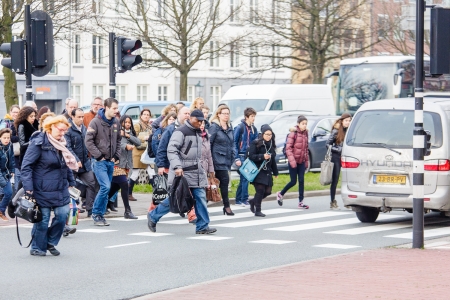Possible measures and measures already applied may be classified as infrastructural measures, vehicle technology measures, and behavioural measures.
Infrastructural measures
Pedestrian crossings should be clearly visible (lighting), recognisable and uniform. Taking into account the specific impairments of older pedestrians, the following measures at pedestrian crossings are possible:
- diminishing the crossing distance by refuges or by extending the pavement;
- supplying more pedestrian crossings with traffic lights;
- setting traffic light intervals to accommodate walking speed of older pedestrians;
- in crowded pedestrian areas: reducing the speed of other traffic by installing elevations (raised junctions) or by completely excluding motorised traffic.
There are a number of initiatives to increase road safety on school routes and other routes frequently used by young pedestrians (see [24] for example). One of them is the so-called safe wave. A ‘safe wave’ is a designated corridor to take children to schools, playgrounds and sports facilities safely, using recognisable pavement markings and signs [25].
Behavioural observation (speed differences and conflicts) by Dutch Fietsberaad [26] and German FGSV [27] implies that cycling in pedestrian areas is safe and practicable, provided the number of pedestrians does not exceed 100 per hour for a profile width of one metre. At 100-200 pedestrians per hour for a profile width of one metre, a ‘segmented profile’ (with a separate cycling strip) is advisable, while at more than 200 pedestrians, joint use of the area is unadvisable. For cyclists, no critical threshold has been determined, although in practice the number of cyclists per hour does not exceed 600.
For more information, see SWOV fact sheet Infrastructure for pedestrians and cyclists.
Vehicle technology
A pedestrian-friendly car front is a frontal construction without any sharp and hard/stiff components, so that, in case of a collision, (serious) injuries of pedestrians are minimised. The frontal construction refers to the entire front of the motor vehicle, and therefore includes the bonnet. Decades of research into the protection of pedestrians resulted in the 1995 European requirements for cars. Since 2015, all new cars have had to be fitted with a pedestrian-friendly front. Opinions about the effect of the measure are rather disparate: the industry expects the measure to have hardly any effect; European Transport Safety Council ETSC expects enormous casualty reductions [28]. It should be noted that implementation of a pedestrian-friendly car front is based on a collision speed maximum of about 30 km/h.
Volvo and Mercedes Benz have chosen a different angle. A in-vehicle radar system and camera detect an approaching pedestrian. The vehicle warns the driver and proceeds to brake automatically.
Side shields for trucks, another vehicle measure, also enhance pedestrian safety. Since 1 January 1995, all new trucks and (semi)trailers have had to be fitted with side shields. For road users such as pedestrians, closed side shields of trucks are more effective in reducing injury severity than open side shields [29]. For more information, see SWOV fact sheet Trucks and delivery vans.
Speed reduction which could be achieved by speed limiters also enhances road safety. Particularly in the urban area, Intelligent Speed Assistance (ISA) could effectively contribute to the safety of pedestrians and cyclists by limiting the speed of high/speed traffic to a safe 30 km/h. However, it will take some time before ISA is introduced. Also see SWOV fact sheet Speed and speed management.
Behavioural measures
Since cars are the most common crash opponents of pedestrians, much may be gained by educating aspiring drivers to make sure they develop appropriate behaviour during driver training. The ‘Regulation concerning driving test requirements’ includes the requirement that, during the driving test, the participant should drive safely near and on specific road sections, such as access roads, entries and exits, pedestrian crossings, and tram and bus stops. The participant should also demonstrate insight into the associated actions and manoeuvres by a permanent awareness of (possible) other road users, particularly vulnerable road users such as pedestrians and cyclists.
In the Netherlands, crossing guards have helped children to cross roads to and from school since 1947; see ‘Regulation crossing guards’’ for more information about legislation concerning crossing guards. Drivers are obliged to stop when crossing guards signal them to do so. In recent years, the number of volunteers has decreased and training crossing guards does not seem to be a police priority. The Crossing Guard Foundation also receives more and more signals that not all crossing guards have undergone training. The Dutch Traffic Safety Association intends to enhance services for crossing guards, so that they will receive the supervision and support needed to carry out their voluntary work properly [30].
Wegman & Aarts [31] also indicate that, in addition to formal education, parents and caretakers could also contribute to the traffic education of children. It appears that, at present, only a minor role is reserved for this informal education [32].
